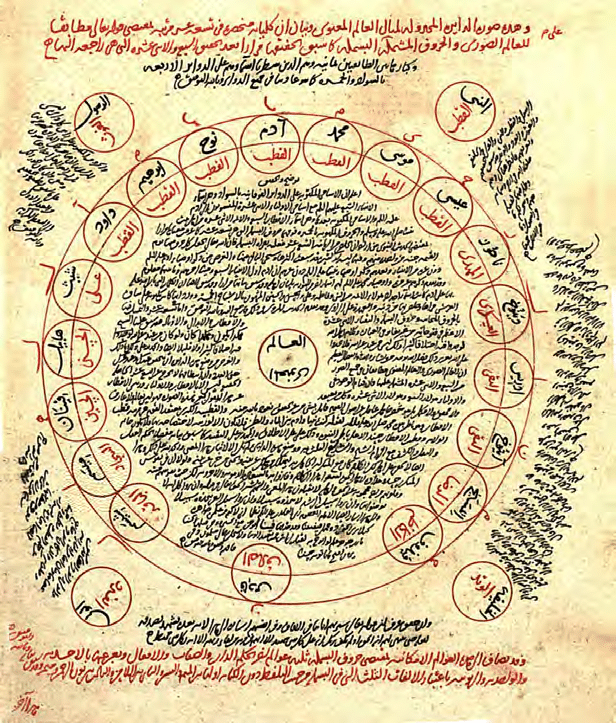This blog post highlights a recently published article by our colleague, Dr. Eliza Tasbihi: “Visionary Perceptions through Cosmographical Diagrams”, in the Journal of the Muhyiddin Ibn ʿArabi Society, 2021.
Eliza Tasbihi is a Specialised Cataloguing Editor of Islamic Manuscripts at McGill’s Rare Books and Special Collections. She completed her M.A. in Islamic Studies from McGill University and her Ph.D. in Religious Studies from Concordia University. Her main areas of research are classical Islam, classical Persian literature, Ottoman studies and Ottoman Sufi literature, and Sufism and Sufi literature.
In her recent article, Tasbihi studies the Mystical knowledge of Heydar Amuli in his work the Text of the Text (Nass al-nusus) by highlighting his cosmographical diagrams, which she believes is the most important part of his work. She also explores the influence of Ibn Arabi’s thought upon Amuli, as well as areas where their doctrine differed.
The paper is divided into several sections with the first providing a brief biography of Amuli, who was a Shi’ite mystic and a Sufi philosopher from 14th century, followed by Ibn Arabi’s influence on Amuli’s thought and work.
The main section discusses the overall importance of circle shapes (dawai’r) in Islamic cosmology, with the application in cosmographical diagrams in Amuli’s work of Nass al-nusus. Here Tasbihi discusses the implication of circle shapes (dawai’r) in Amuli’s diagram as an indication of the “science of balance and its correspondence between the spiritual and corporeal worlds” and that dawair brings balance to the world. Tasbihi goes on to discuss how Amuli used circular forms not only to explain difficult esoteric concepts, but also to refer to specific theological topics in his work, such as prophethood, Imamhood, “spiritual friends of God” (awliya) and Prophet’s ascension.” She notes that, “the diagrams are employed as clear and efficient methods of presenting cosmological ideas”, in addition to the inter-relations that connect these diagrams.

Tasbihi, Eliza. (2021). Visionary Perceptions through Cosmographical Diagrams : Mystical Knowledge from Ḥaydar Āmulī’s (d.787/1385) Naṣṣ al-nuṣūṣ fī sharḥ Fuṣūṣ al-ḥikam. 69. 31-83.
Tasbihi consulted four manuscripts to study and clarify Amuli’s argument and details of the diagrams. Diagrams numbered 1, 7-11 are drawn from Amuli’s commentary on Ibn Arabi’s Fusus al-hikam. She also highlights Amuli’s interpretation of the presence of the number 19 represented by its sacredness and by its relation to the awliya. The number 19 is said to resemble the 19 letters of the basmala, which opens all but one Quranic Sura. Further, the number 19 is present within the awliya (the chain of prophets and their spiritual representatives/spiritual friends of God) consisting of 7 prophets and the 12 Imams who spiritually received divine knowledge. Amuli’s dedicates one diagram to the 12 Imams, which emphasizes how Amuli’s Shi’a doctrine influenced his understanding of Ibn Arabi’s Sunni text of the Fusus.

Tasbihi, Eliza. (2021). Visionary Perceptions through Cosmographical Diagrams : Mystical Knowledge from Ḥaydar Āmulī’s (d.787/1385) Naṣṣ al-nuṣūṣ fī sharḥ Fuṣūṣ al-ḥikam. 69. 31-83
Tasbihi summaries by arguing that, on the one hand Amuli’s thoughts were influenced by Ibn Arabi, as in his definition of the perfect man (Insan Kamil) and divine knowledge, and on the other hand Amuli borrowed Ibn Arabi’s cosmological concepts in order to develop his “esoteric-allegorical aspects of Shi’a theology”. Therefore, she concludes that Amuli’s Text of the Text (Nass al-nusus) is a Shi’a interpretation of Ibn Arabi’s Fusus al-hikam.
Access the Tasbihi’s article at McGill library here: https://mcgill.on.worldcat.org/v2/oclc/607401882
To know more about Dr. Eliza Tasbihi and her works please click here: https://independent.academia.edu/ElizaTasbihi
Ibn Arabi’s فصوص الحكم / Fuṣūṣ al-ḥikam can be found here: https://mcgill.on.worldcat.org/v2/oclc/122782398


